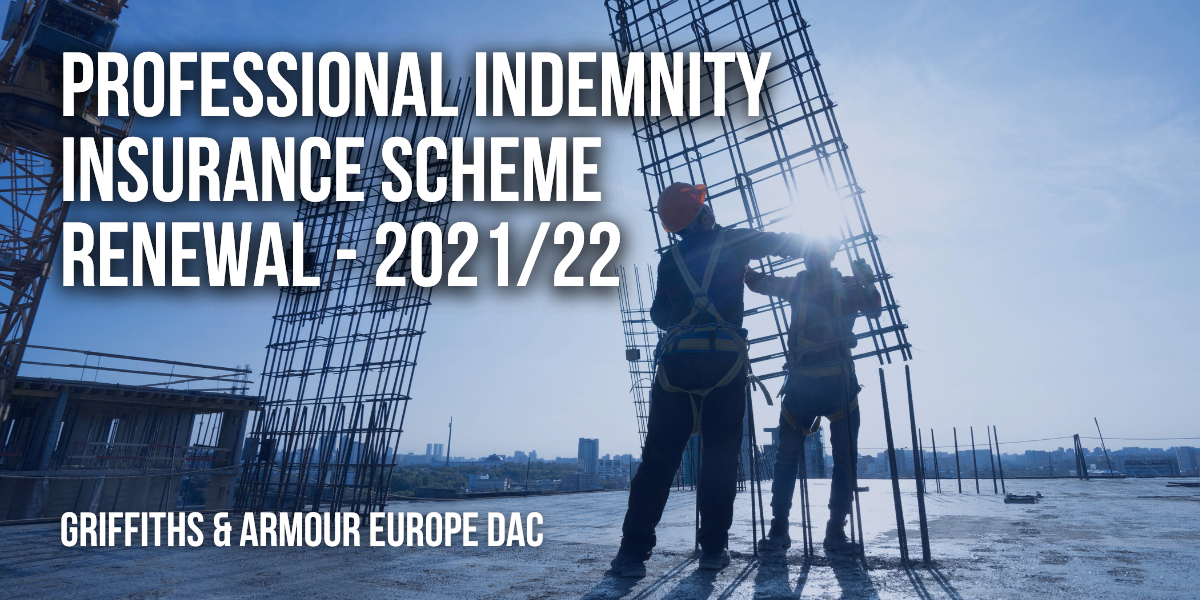Background and context
That the current PI market for construction risks is a challenging one needs little introduction. From a PI perspective, 2021 has been an extraordinary year where issues around the availability, cost and specification of cover have played out across the national media and been the subject of Oireachtas committee hearings. That is not something we have encountered previously, and it points to an underlying and fundamental problem in the liability landscape within which consultants are operating.
Whilst many of the issues are global, there are specific local challenges which we are continually seeking to address. Through our association with professional bodies and direct discussions with authorities such as the Office of Government Procurement we have continued to fight for change on the issues that matter most to our clients. In our 2020 Information Alert we reported on our representations to Government around the need for liability caps within the GCCC conditions of engagement and it has been indicated that these should be in place by the end of this year. This was one of several items that we and others have been campaigning for and whilst it is a step in the right direction, there is more that needs to be done.
It is wrong that we should be receiving calls every week from firms who have been unable to secure PI cover and it is worrying that some firms will now be operating without insurance. We believe that there needs to be a rebalancing of risk and reward within the construction sector and that this is the only rational way to encourage insurer appetite and drive sustainable competition within the insurance market. As we move towards 2022, we want to assure you that we will continue with our efforts to achieve that and to support the work being done at industry level to address the significant challenges on liability and insurance.
Securing Insurer support
Despite those challenges, which cannot be over-emphasised, we are pleased to confirm that we have secured insurer support and renewed our construction scheme facilities for a further 12 -month period, from 1st November 2021. This annual exercise renews the framework under which your individual PI policies are placed and sets the scheme insurers’ broad strategy for the insurance year ahead. This process is different from the renewal of your individual PI policies, but very much instrumental in us being able to continue to offer our scheme approach.
Perhaps even more so than last year, those negotiations were marked by very difficult discussions on some complex issues:
-
- The continuing capacity challenges in the wider PI insurance market and insurers’ appetites for construction risks.
- What degree of macro-level pricing changes are appropriate to ensure our Scheme can continue to deliver on its promises of providing broad, sustainable protection which is both effective and value for money.
- The specific issue of fire safety cover which continues to be under intense scrutiny.
- The broader PI insurance market response to the need to clarify their cyber liability exposures and risks related to Pyrite and Mica.
All of which are issues we cover within this guidance document.
Predictions for the cost of cover
Inevitably, the turmoil many of you will have heard about in the wider PI market referenced at the outset of this document has also impacted our scheme facilities and we all faced the challenge of an insurer led drive for increased premium as we worked through the last 12 months.
We recognise that no increase in cost was welcome, particularly at a time where we faced unprecedented uncertainty managing the consequences of a global pandemic. But such an increase was a necessary step to:
-
- continue to attract sufficient quality insurance capital to our scheme portfolio
- ensure that we can continue to meet the promises made as part of our long-term offering
- leave our scheme in a stronger position to weather the challenges that lie ahead
In terms of underwriting action, it feels like we are moving to a point where rate increases will be more modest and at a much lower level than firms will have experienced last year. We will also start to see the ability of underwriters to exercise much more underwriting judgement on individual cases and whilst we’re certainly not out of the hard market yet, there are signs of better days ahead.
Coverage changes
Whether those better days come to pass in 2022/23 and beyond is going to be heavily influenced by one issue: fire safety. This is an issue that has continued to dominate in 2021 and whether we are looking at evidence from the Inquiry into the tragedy at Grenfell tower or the emergence of issues closer to home, the potential for the scale and severity of these risks to create a very significant and potentially grave threat to our ability to continue to offer our scheme specification is very clear. As a result, and with a view to preserving a specification that we can be confident recommending, there will be a notable coverage change applicable to all scheme renewals effective from your renewal date, post-1st November.
Fire Safety
We continue to engage with industry, regulators and Government about the continuing inability of the PI insurance market as a whole to offer cover that adequately transfers ‘fire safety’ risks from consultants’ and contractors’ balance sheets to insurers.
It has become our increasing belief that the improvement of the legal, commercial and operational conditions for those involved in designing and constructing the built environment is the only practical and sustainable long-term solution to this problem. On behalf of our clients, we have communicated that belief directly and unequivocally to Government as well as those professional and trade associations that we advise.
For now, there is little doubt that the insurance market has continued to reduce and remove cover in relation to fire safety aspects and we have seen policy language from various bodies (such as the RICS and the International Underwriting Association (‘IUA’), the voice for non-Lloyd’s insurance companies in the London Market) which provide for a scope of cover which limits policy coverage quite significantly. Similarly, we have had continuing dialogue with the broader market on the nature of the cover they are prepared to offer, to whom and on what terms.
Without exception, the insurers with whom we have engaged are limiting cover further and some are adopting an increasingly ‘standard’ position which is to either:
-
- Exclude cover for fire safety matters entirely; or
- Significantly restrict coverage for such matters, by taking some (or all) of the following approaches:
- Restricting coverage to claims arising from negligence only (i.e. the policy excludes contractually assumed liabilities which go further than imposing a duty of ‘due skill and care’).
- Further limiting cover to apply to the actual costs of ‘rectification’ only. This means that cover applies only if an to the extent that the claim is for the cost of the re-performance of the insured’s work, or for rectification costs. Claims for delay are therefore not generally covered.
- Often including a broad exclusion of indirect or consequential losses. This generally means there is no cover for loss of profit, loss of rent, or production value.
- Removing cover for any claims arising from bodily injury.
It is against this backdrop that we have been negotiating the fire safety cover for our own Scheme. The positive news is that the ‘default’ position for the majority of our clients is that:
-
- We have been able to maintain the basis on which cover has always been historically provided (i.e. the broad legal liability basis of cover) and we will continue to provide cover for ‘indirect or consequential losses’ as now.
- There will be no move to restrict the cover to ‘negligence’ and/or rectification’ costs only.
- The policy will still provide an aggregate, costs inclusive limit of indemnity.
This position has, however, come with certain conditions. Effective from the 1st November 2021, but applying at the date of your next renewal, the limit of indemnity available in respect of a ‘legacy’ Fire Safety Notification (‘FSN’) will change. Please follow this link for a refresher on the policy definition of a FSN.
The intent is that where a FSN is made in respect of a claim or circumstance that might give rise to a claim arising from:
-
- any building work commenced before 1st November 2019; the Limit of Indemnity available will be no greater than €1.3M. That limit will apply in respect of all such FSNs in the policy year. As now, that sum will be inclusive of costs and in the aggregate.
- any building work commenced on or after 1st November 2019, the Limit of Indemnity will be no greater than your policy limit (i.e. a costs inclusive aggregate sum at the level of your general limit of indemnity).
These two limits are not separate: the insurers will only pay a maximum of the limit of indemnity for all FSNs in the period of insurance (i.e. you won’t enjoy a €1.3M limit for ‘legacy’ claims and a separate limit for ‘new’ claims).
There is a recognition from the Scheme insurers that there will be scenarios which might arise which don’t readily lend themselves to an easy characterisation one way or the other. We will need to work through those scenarios as and when they arise in the years ahead and in doing so there will be a need to use all the pragmatism that we have consistently applied in the past.
Impact of the change
As ever, the test for us in assessing any proposed changes to our scheme policy coverage is whether the approach being adopted by insurers is reasonable and proportionate. Our belief is that not only does this change provide cover which is broader than that generally available in the market, but that it is also a change which is of critical importance in preserving our 80+ year scheme facilities for the next decade.
The simple reason for that interlinked belief is that the cover we have provided to date for legacy work is so out of step with what the PI insurance market offers today, that all our clients could become collectively exposed to being the last people standing, which is to say, the last people still solvent, trading and with deep insurance pockets for claimants to target. Our scheme – and more importantly our clients to whom it provides protection – then potentially become the safety net, not for the errors and omissions of those whom it insures, but for all the ills, problems and failings of how the built environment has been procured and constructed for a generation or more. The only result of that would be the loss of insurance market support, ending up with an overall specification of cover which is objectively worse than that at which we have arrived. In entirely plausible scenarios, we might end up with no scheme offering at all.
The story behind why the industry has ended up where we have is a complicated one. It will have been evident to anyone involved in construction that the PI insurance market has been continuing to restrict and remove cover in this area. That further change to the cover was likely was a frequent warning of ours.
That we have been able to maintain very broad cover some 4-years after Grenfell and a decade on from the ‘Celtic Tiger’ has put all our clients in a very strong position as regards protection against genuine FSN claims. We would hope that, by now, any material FSN problems relating to legacy matters would have been made to Scheme insurers. If you are in any doubt about whether to notify anything then we would strongly recommend speaking to your usual G&A contact. For initial advice, please refresh yourself on the issues by reading our recently revised guidance here.
The change we have negotiated is one that we genuinely believe, having regard to the alternative options available, is in the long-term best interests of our clients and the supply side of the industry generally.
We could have simply agreed to restrict cover in the way the PI insurance market generally is seeking to do. This would have provided a higher limit of indemnity for FSNs, certainly, but it would have done so at a considerable cost. That cost would have been to remove essential protections in relation to most contractually assumed liability. The cost would have included the removal of all other aspects of cover, other than the direct expenses of rectifying the work that was undertaken. The cost would have been to expose our clients to uninsured exposures for delay and bodily injury claims. The cost would have been to provide to our clients what amounts to an insurance product of questionable value.
The future
Our belief is that this is the last change needed to this aspect of cover. Critically, our insurer partners now share our belief that the impact of legislation such as the Building Control Amendment Regulations in Ireland and lessons learned in more recent years will bring about an environment which is objectively better than what has gone before. This is one of the cornerstones of our argument to preserve the ‘normal’ cover our clients will enjoy for the work they do designing the buildings of today and tomorrow.
Inevitably, this will again see Scheme clients enjoy much wider cover for fire safety claims than most of their peers. Our belief is that through the changes implemented to date and a greater focus on quality and safety, this divergence will be a sustainable one.
As ever, we will continue to monitor the situation closely, report frequently on any developments, and work with industry and other relevant bodies to try to effect the broad Government led changes that are still required.
Cyber Liability clarification
A further sign of our changing times is the increasing Cyber threats we are collectively facing. To comply with recent regulatory requirements around whether (and to what extent) your insurance policies cover ‘cyber’ liability, our Scheme insurers will be introducing an exclusion of liability for cyber liabilities and removing those modest extensions of cover in respect of the payment of crisis consultants’ fees and claims for breaches of data protection legislation around the use of personal data.
We don’t believe that any of our clients have ever used the extensions to cover introduced and in place since 2014, but given the rising prominence of cyber liability and the potentially business critical importance of dedicated cyber insurance products, we report in more detail on those changes here.
Pyrite and Mica
One final point to mention is the position on cover for claims relating to Pyrite and Mica. During 2021, insurers began to introduce a restriction on cover for such claims and this will continue to be the case as individual policies fall due for renewal.
The restriction reflects a more general position being adopted by insurers who are conscious that responsibility for such losses should rest with the parties responsible for the manufacture and supply of defective materials and that affected homeowners should have access to the appropriate Government redress schemes that are already in place.
In negotiating the wording of the restriction with insurers, we were reluctant to accept an outright exclusion. Whilst the legacy risk is not one for the PI insurance market, we feel it is important for consultants and contractors to be able to support the necessary assessment and remediation of affected properties. With that in mind, we were able to secure an element of cover from insurers and ultimately the following form of words was agreed:
‘The Insurer will not be liable in respect of…
any Claim arising from any loss, cost or expense directly or indirectly arising out of, resulting as a consequence of, or related to the use, specification, identification or exposure to Pyrite or Mica or materials or products containing Pyrite or Mica whether or not there is another cause of loss which may have contributed concurrently or in any sequence to a loss.
For the avoidance of doubt, the provisions of Exception (20) shall not apply to any Claim against the Insured arising out of assessment, specification, categorising, certification and remediation in accordance with I.S. 398 and I.S. 465 where the Insured is registered under Engineers Ireland (Pyrite) Register and/or (Concrete blocks and Mica) Register.
In respect of any Claim arising from such activities the maximum amount the Insurer will pay in respect of any one Claim and in total for all such Claims first notified in the Period of Certificate (including Extensions) shall not exceed the Limit of Indemnity.’
The effect of this wording is to introduce an exclusion for claims relating to pyrite and mica. This exclusion will not, however, apply to claims arising from assessment, specification, categorisation, certification and remediation in accordance with I.S. 398 and I.S. 465 where you are registered under Engineers Ireland (Pyrite) Register and/or (Concrete blocks and Mica) Register.
We hope that this overview provides a good understanding of current market conditions, the changes that will be introduced to our scheme this year and the reasons behind the action being taken by insurers. As ever, should you have any questions or if you would simply like to chat through any aspect, then do please get in touch with your usual G&A Account Handler.


